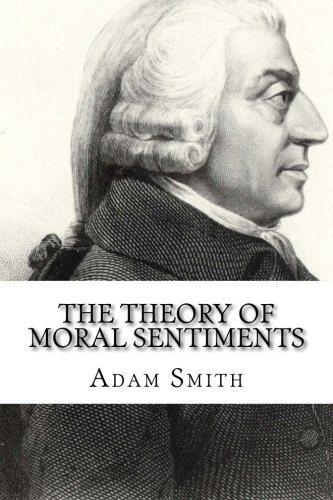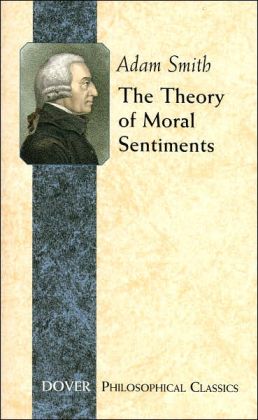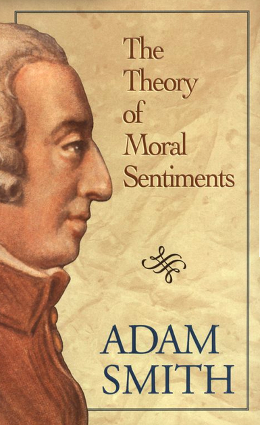The theory of moral sentiments
Data: 4.03.2018 / Rating: 4.7 / Views: 743Gallery of Video:
Gallery of Images:
The theory of moral sentiments
The Theory of Moral Sentiments them, serve rather to disgust and provoke us against them. The moral sense, though not moral ideas, is innate, as can be seen from the sentiments of small children (1725: ). On Hutcheson's view, what the moral sense approves of is above all the general calm desire of the happiness of others, in distinction from particular benevolent passions like love and compassion (1728: 175). The Theory of Moral Sentiments, Smith's first and in his own mind most important work, outlines his view of proper conduct and the institutions and sentiments that make men virtuous. Here he develops his doctrine of the impartial spectator, whose hypothetical disinterested judgment we must use to. The Theory of Moral Sentiments (First Edition) Adam SMITH (1723 1790) How selfish soever man may be supposed, there are evidently some principles in his nature, which interest him in the fortunes of others, and render their happiness necessary to him, though he derives nothing from it, except the pleasure of seeing it. The Theory of Moral Sentiments, Smith's first and in his own mind most important work, outlines his view of proper conduct and the institutions and sentiments that make men virtuous. Adam Smith's Theory of Moral Sentiments (1759) lays out his moral philosophy, and provides the philosophical and psychological underpinnings of the. The Theory of Moral Sentiments, Smiths first and in his own mind most important work, outlines his view of proper conduct and the institutions and sentiments that make men virtuous. Here he develops his doctrine of the impartial spectator, whose hypothetical disinterested judgment we must use to distinguish right from wrong in any given situation. The Theory Of Moral Sentiments was a real scientific breakthrough. It shows that our moral ideas and actions are a product of our very nature as social creatures. It argues that this social psychology is a better guide to moral action than is reason. The Theory of Moral Sentiments. Book from the collections of University of Lausanne. Moral sense theory (also known as moral sentimentalism) is a theory in moral epistemology and metaethics concerning the discovery of moral truths. Moral sense theory typically holds that distinctions between morality and immorality are discovered by emotional responses to experience. Adam Smith was a professor of moral philosophy in the University of Glasgow. He is perhaps better known for his work in economic theory, An Inquiry into the Nature and Causes of the Wealth of. The Theory of Moral Sentiments, written by Adam Smith in 1759, is an important work in the theory of capitalism, wherein the ethical, philosophical, psychological and methodological underpinnings to Smith's later works are provided, including The Wealth of Nations (1776). Adam Smith's Theory of Moral Sentiments (1759) lays the foundation for a general system of morals, and is a text of central importance in the history of moral and political thought. Adam Smith's Theory of Moral Sentiments (1759) lays the foundation for a general system of morals, and is a text of central importance in the history of moral and political thought. The Theory of Moral Sentiments was published in 1759, and The Wealth of Nations in 1776, the same year as the Declaration of Independence. Amartya Sen is a Nobel Prizewinning economist, known for his work on the way economics affects the wellbeing of humans. The very different sentiments with which the spectator views those different punishments, is a proof that his approbation of the one is far from being founded upon the same principles with that of the other. The Theory of Moral Sentiments Part I: Of the Propriety of Action Section I: Of the Sense of Propriety. Section I: Of the Questions which ought to be examined in a Theory of Moral Sentiments. Section II: Of the different Accounts which have been given of the Nature of Virtue. Smith on Moral Sentiments Sympathy retained sometimes in this version, always with that meaning. Our joy over the deliverance of the heroes of tragedy or romance The Theory of Moral Sentiments was published in 1759, and The Wealth of Nations in 1776, the same year as the Declaration of Independence. Amartya Sen is a Nobel Prizewinning economist, known for his work on the way economics affects the wellbeing of humans. III: Of the corruption of our moral sentiments, which is occasioned by this disposition to admire the rich and the great, and to despise or neglect persons of poor and mean condition Section I: Of the Sense of Propriety [ edit. In The Theory of Moral Sentiments Smith suggests that by having experiences of moral and immoral actions people develop a moral code of principles. He presents justice as being different from other virtues in that it is the only one that is susceptible to enforcement, and the only rule of virtue people can be punished for breaking. About The Theory of Moral Sentiments Best known for his revolutionary freemarket economics treatise The Wealth of Nations, Adam Smith was first and foremost a moral philosopher. In his first book, The Theory of Moral Sentiments, he investigated the flip side of. The Theory of Moral Sentiments (First Edition) audiobook Adam SMITH (1723 1790). Adam Smith's Theory of Moral Sentiments (1759) lays out his moral philosophy, and provides the philosophical and psychological underpinnings of the betterknown Inquiry Into the Nature and Causes of the Wealth of Nations (1776). The Theory of Moral Sentiments Questions and Answers. The Question and Answer section for The Theory of Moral Sentiments is a great resource to ask questions, find answers, and discuss the novel. Ask Your Own Question The Theory of Moral Sentiments is the work of a civic moralist educating and exhorting but also reflecting the values of the middling ranks of that provincial city. The moral ideal that underlies the work is the refinement of selfcontrol and sentimental feeling. The Kessinger book is a bad reprint of a couple of chapters of Smith's entire The Theory of Moral Sentiments and runs less than their stated 60 pages. For half the price, you can get a brand new complete printed copy (running several hundred pages) or get the whole thing on Kindle for 99 cents. The Theory of Moral Sentiments and millions of other books are available for Amazon Kindle. Learn more Enter your mobile number or email address below and we'll. Book digitized by Google from the library of Harvard University and uploaded to the Internet Archive by user tpb. The Theory of Moral Sentiments is one of two major works that Adam Smith wrote, and to try and understand the man who wrote down and formalised many of the key concepts of a capitalist society, and anyone wanting to understand his more famous book. The Theory of Moral Sentiments was bedoeld als eerste deel van een drieluik. Dit eerste deel handelde over morality (ethiek), waar het tweede deel ( The Wealth of Nations ) (1776) en het derde deel respectievelijk over prudence (wijsheid of bedachtzaamheid) en justice (rechtvaardigheid) zouden gaan. The Theory of Moral Sentiments By Adam Smith. SHARE POST: Since the first publication of theTheory Of Moral Sentiments, which was so long ago as the beginning of the year 1759, several corrections, and a good many illustrations of the doctrines contained in it, have occurred to me. But the various occupations in which the different accidents of. On this day, in 1759, Adam Smith published The Theory of Moral Sentiments. Since the Greeks, philosophers had tried to work out the basis of human ethics: what it was that made some actions good and others bad. Of the Corruption of our Moral Sentiments, which is occasioned by this Disposition to admire the Rich and the Great, and to despise or neglect Persons of poor and mean Condition. of merit and demerit; or, of the objects of reward and punishment. The Theory of Moral Sentiments is stunningly relevant today. Whereas The Wealth of Nations featured the invisible hand, the metaphor that dominates Moral Sentiments is the impartial spectator. The spectator represents ones conscienceones ability to perceive the divinely ordained objective standard of right and wrong. Adam Smiths book on the nature of morality was a major work of enlightenment reasoning, and an example of the intellectual mapping of the world which occupied the minds of eighteenthcentury philosophers, lexicographers and encyclopaedists. Theorie der ethischen Gefhle (engl. The Theory of Moral Sentiments) ist ein erstmals 1759 in London in zwei Bnden verffentlichtes philosophisches Werk von Adam Smith. Er erklrt darin umfassend, aus welchen Grnden es den Menschen mglich sei, freinander das Gefhl des Mitgefhls zu empfinden. The Theory of Moral Sentiments, is a book about how society conducts itself. Smith examines the how and why, of peoples approach to life. Smith believes people are inherently social. Of the Theory of Moral Sentiments, and the Dissertation on the Origin of Languages. The science of Ethics has been divided by modern writers into two parts; the one comprehending the theory of Morals, and the other its practical doctrines. The foundation for a system of morals, this 1749 work is a landmark of moral and political thought. Its highly original theories of conscience, moral judgment, and virtue offer a reconstruction of the Enlightenment concept of social science, embracing both political economy and. The Theory of Moral Sentiments Ebook written by Adam Smith. Read this book using Google Play Books app on your PC, android, iOS devices. Download for offline reading, highlight, bookmark or take notes while you read The Theory of Moral Sentiments. The Theory of Moral Sentiments Quotes (showing 130 of 37) The great source of both the misery and disorders of human life, seems to arise from overrating the. Adam Smith developed a comprehensive and unusual version of moral sentimentalism in his Theory of Moral Sentiments (1759, TMS). He did not expressly lay out a political philosophy in similar detail, but a distinctive set of views on politics can be extrapolated from elements of both TMS and his Wealth of Nations (1776, WN); student notes from his lectures on jurisprudence (, LJ. (Partial) Summary of A Theory of Moral Sentiments October 5, 2014 by William Eden 1 Comment Adam Smith is best known for being the father of modern economics with the publishing of his magnum opus The Wealth of Nations. A 1 S rst publication of the theory of moral sentiments, which was so long ago as the beginning of the year 1759, several corrections, and a good many illustrations of the doctrines contained in. Much earlier, in 1759, however, Smith published another work, The Theory of Moral Sentiments, while he was a professor of moral philosophy at the University of Glasgow; he produced a revised. About The Theory of Moral Sentiments. Written in 1759 by Scottish philosopher and political economist Adam Smith, The Theory of Moral Sentiments provides much of the foundation for the ideas in his later works, most notably in The Wealth of Nations. Through this initial text, Smith expresses his general system of morals, exploring the propriety of action, reward and punishment, sense of duty
Related Images:
- Gary moore the best of the blues
- X art up and close
- E s posthumus
- Window 7 sp1 64 bit
- Windows 8 office 13 activator
- A m s
- Tae bo cardio
- Power rangers super legends ps2
- Spiderman the amazing french
- Lil freak usher
- Cars 2 video game
- Network centric enterprise
- Buy Buttons in Your Customers Brain
- Meaning of life python
- No one is safe
- Front End Web Development Ranch Guide
- Naruto Shippuden 2014
- Civilization alpha centauri
- Will grace season 7
- Todo lo que tu quieras
- Vanderpump rules s02e17
- Pro dj basic
- Taylor swift t pain
- The godfather dut
- Tinker bell secret of the wings
- Pirates of the caribbean at worlds end pc
- Stranger in my house
- Oh oh cherso
- The unsinkable molly brown 1964
- Men boys and toy
- Game of thrones season 3 english sub
- Born to win
- 2018 scream 4 avi
- Counter strike 16 game
- Spit on your grave 2
- HorribleSubs Seirei Tsukai no Blade Dance 720p
- The king of the fighters
- 2018 telugu hd
- Compass Placement Test Study Guide
- Metallurgy and non destructive testing manual
- The police every breath
- 70 410 installing and configuring windows server
- Close up 2011
- Lonely Planet Edinburgh City Map
- Stieg larsson epub dutch
- Steven wilson live
- Chris rice amusing
- International players anthem
- 40 year old virgin yify
- Microsoft office professional 2013 activation
- Dead space downfall swesub
- Metallica kill em all album
- Naruto shippuuden 284
- Batch leaked photo
- Haider movie 2014 hindi
- Juan luis guerra besos
- Big bang s07 e01
- Crack resident evil 6
- Crusader kings ii 21
- The secret mysteries of america
- The Las Vegas Story
- Compartiment tueurs
- Wwe 29 06 2014
- The Bruce Lee Collection
- Mrperfect mp3 songs
- 13 ghost 1960
- Greatest love songs of 90s
- The grand seduction 1080p
- New releases 2014 week 24
- Lil wayne new song
- 2001 l odysse de l espace
- Mywife No 0053












